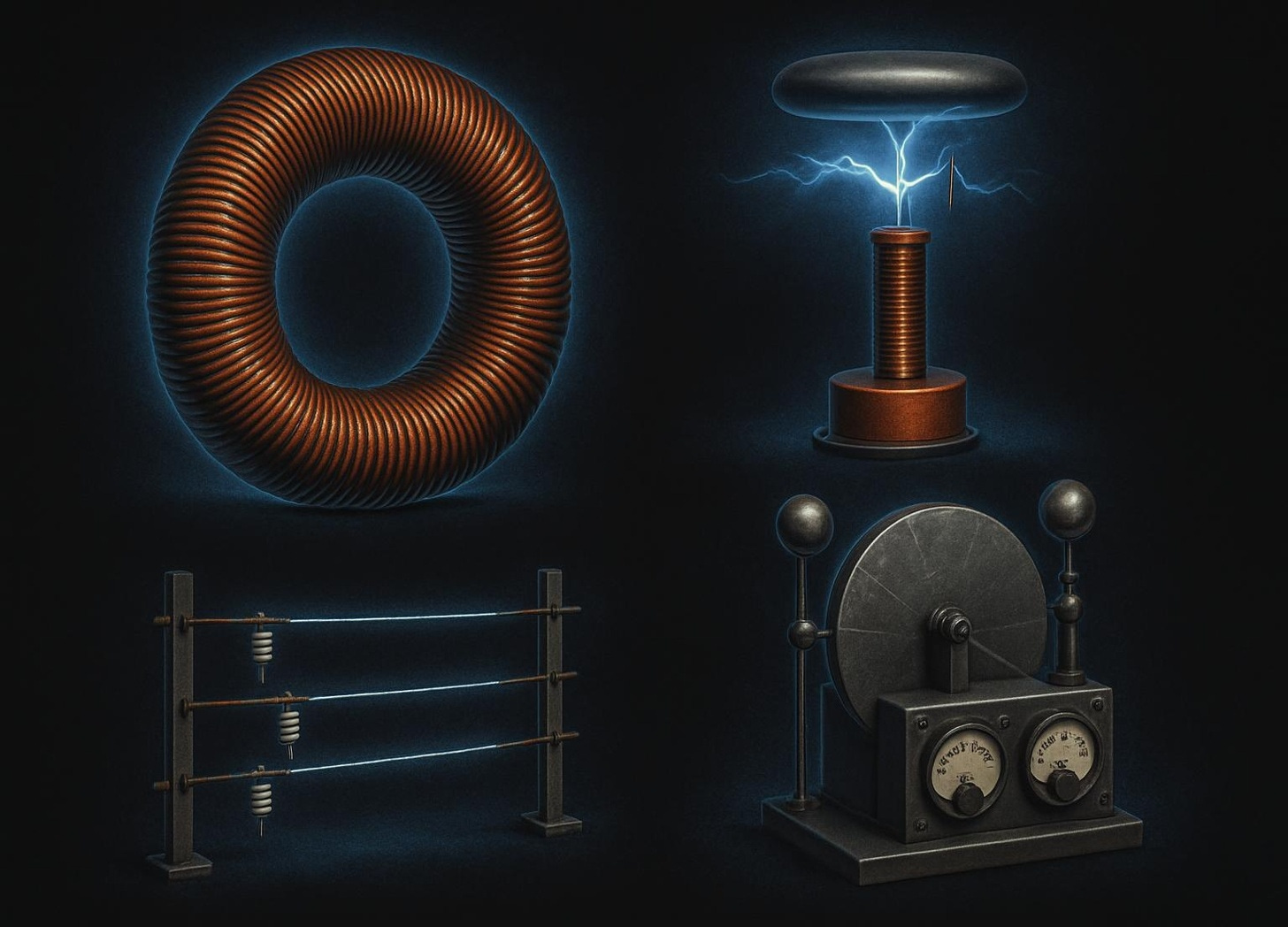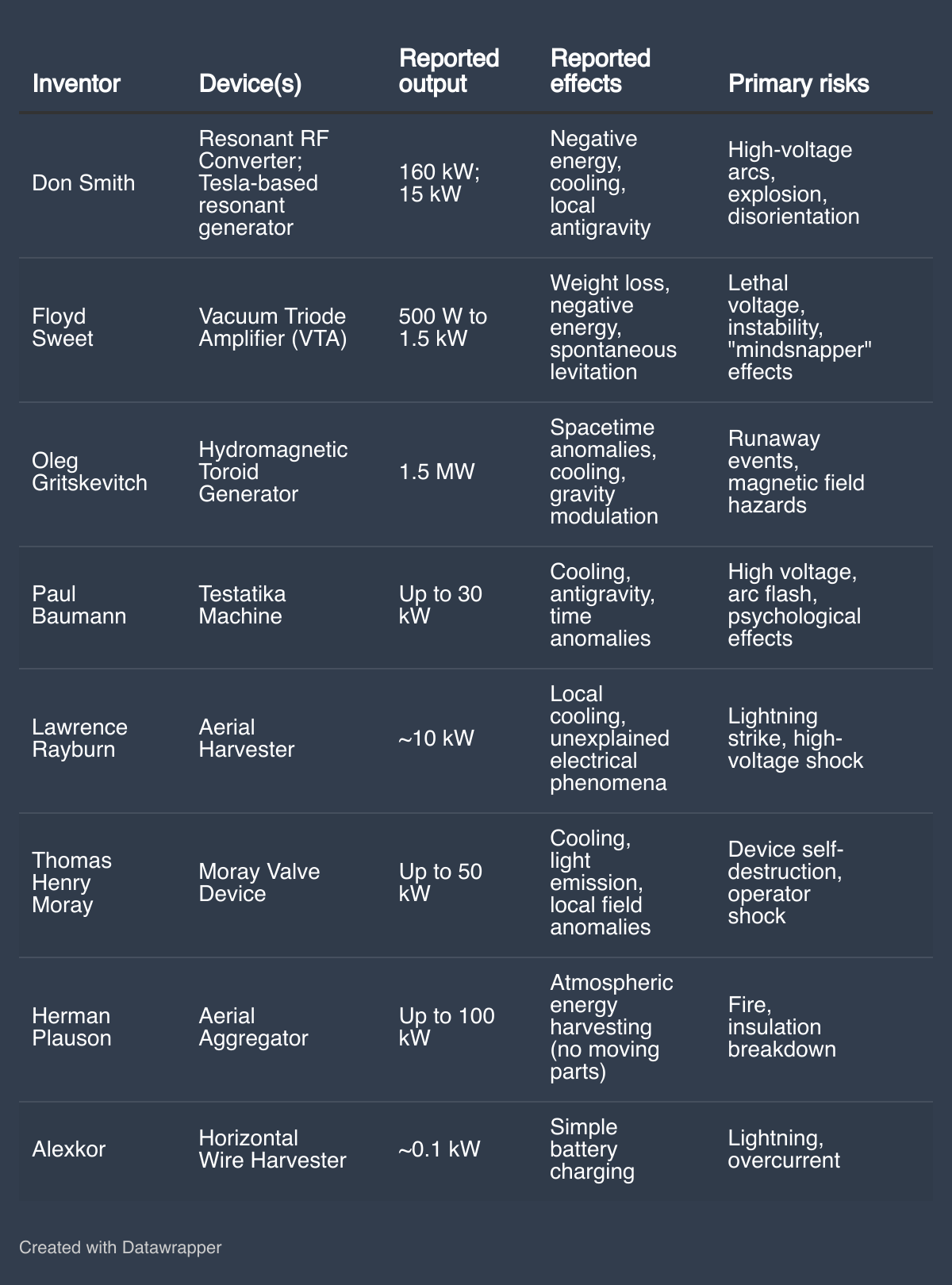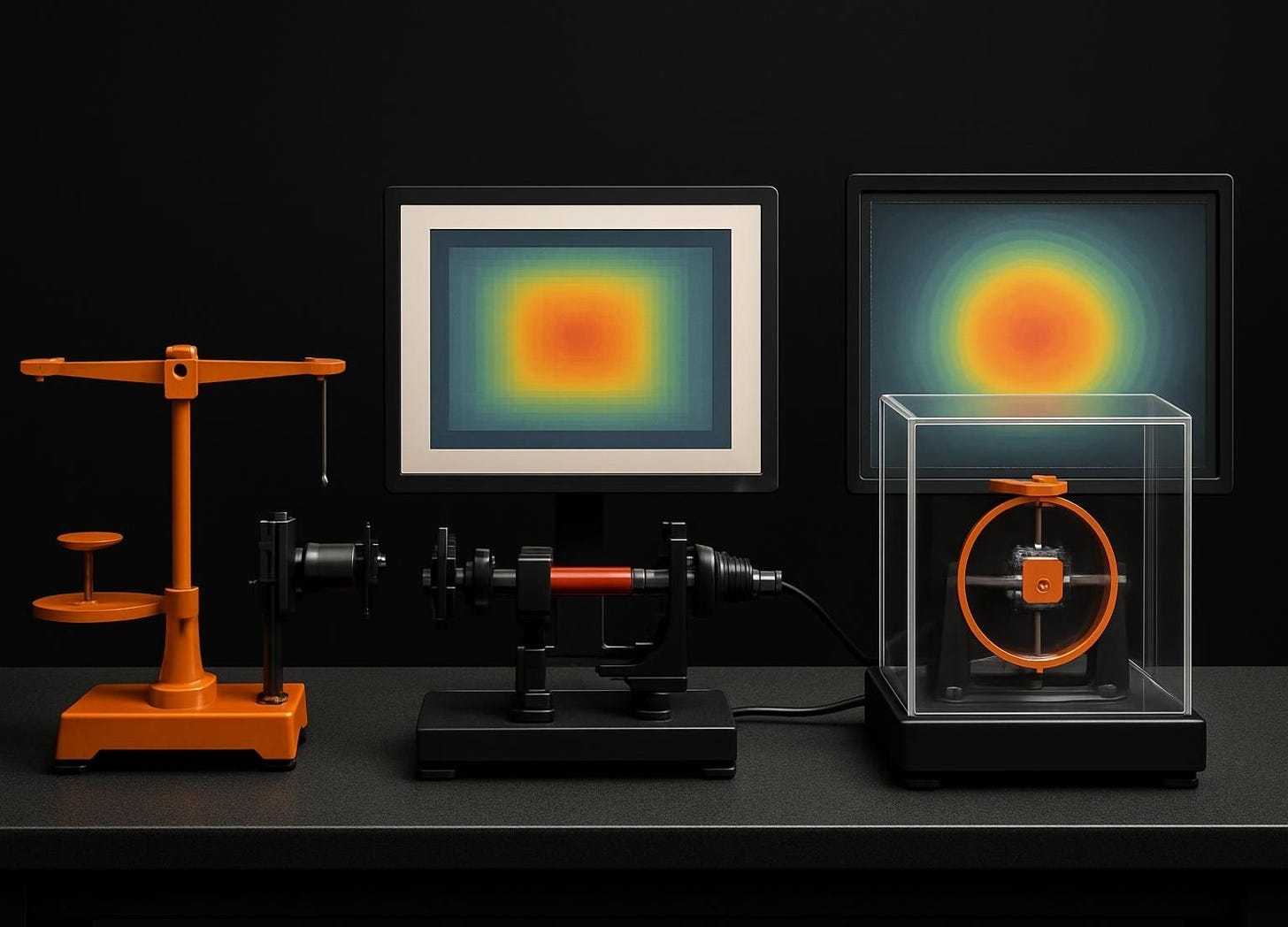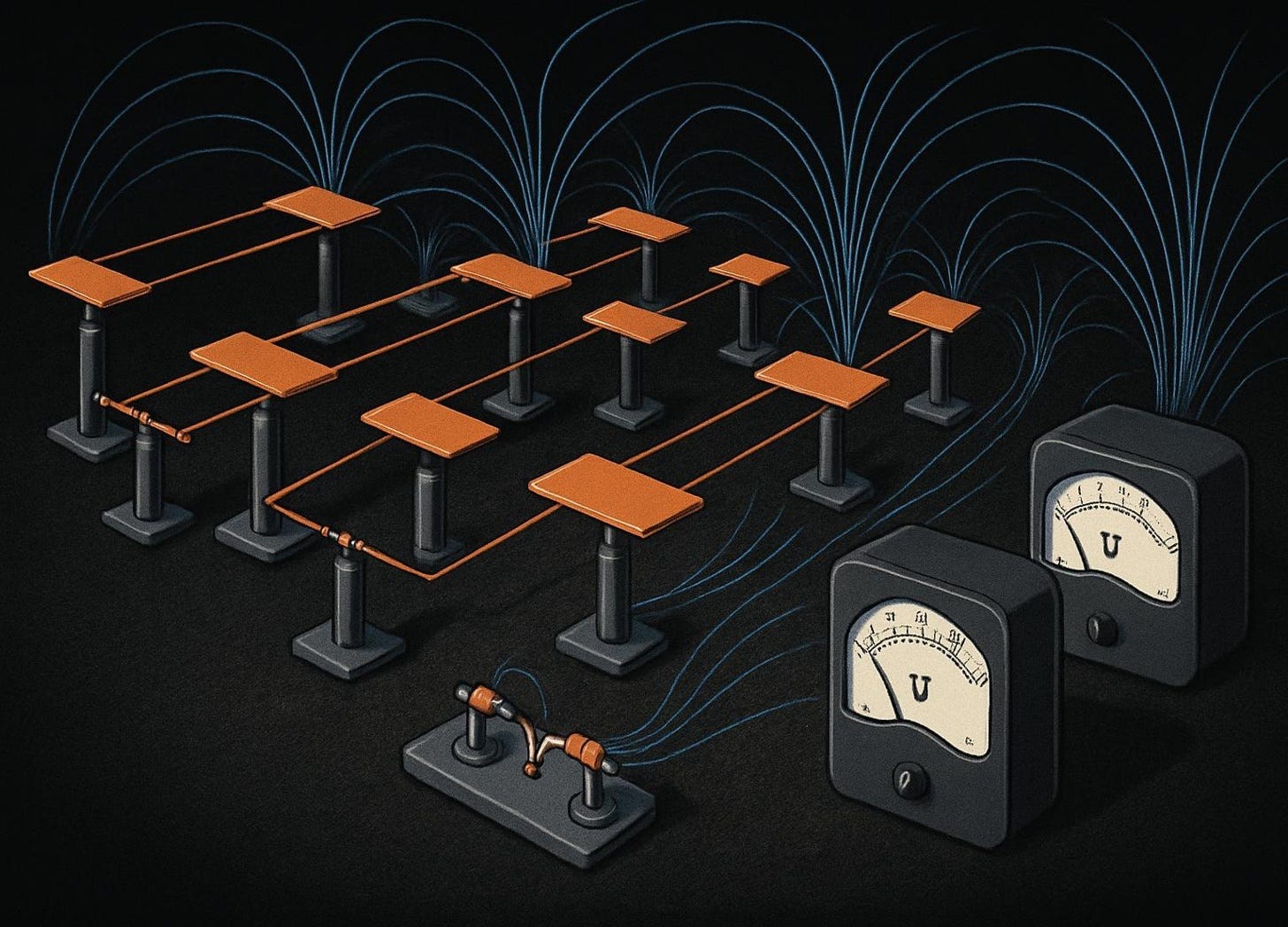Overunity and the Edge of Physics
Experiments that blur the line between proof and belief
🧲 Reports claim a single spark gap can release 160,000 watts. Which names and risks matter most?
The field of free energy and overunity devices is packed with dramatic claims, technical puzzles, and stories of both discovery and caution. Inventors like Don Smith, Floyd Sweet, and Oleg Gritskevitch have presented devices that, if verified, would upend our understanding of physics and energy economics. Reported effects range from negative energy and antigravity to cooling and time anomalies, The risks are equally serious: explosions, lethal voltages, and psychological hazards.
Let’s break down the most cited devices, their inventors, reported power outputs, the exotic effects claimed, and the existential risks that come with attempting to harness the unknown. Each section also addresses how laboratory controls, device engineering, and measurement integrity play a role in separating myth from mechanism.
👉 Advanced Rediscovery brings you weekly briefings that cut through the noise with curated insights from my 10+ years of research in AI, extended electromagnetism, the quantum vacuum, and information theory.
In today’s briefing
🧲 Inventor-attributed devices range from 0.1 kW to 1.5 MW output
⚡ Reported effects include antigravity, cooling, and negative energy
🔬 Measurement integrity and shielding are critical for validation
🧠 Existential risks span explosion, electric shock, and psychological effects
🤔 Device categories cover aerial harvesters, resonant converters, and more
Survey of Claimed Free Energy Devices, Effects, and Risks
The search for free energy has produced a long roster of devices, each attributed to inventors with power outputs that sometimes rival industrial generators. Reports include effects that stretch credulity, from antigravity to local spacetime distortion.
Yet, the risks are just as dramatic. Lethal voltages, unexplained explosions, and even psychological effects like so-called “mindsnapper” events are cited. Understanding the field means looking at both the hardware and the hazards.
A survey of free energy devices, showing their diversity and the risks they reportedly carry.
Devices and their Inventors
Exotic effects reported include negative energy emission, local antigravity, cooling, spontaneous levitation, and time dilation. Some inventors, notably Floyd Sweet and Paul Baumann, report that mixing negative and positive energy outputs could cancel in grid applications.
Existential risks are not limited to technical failure. Lethal voltages, catastrophic energy release, and psychological effects such as confusion or “mindsnapper” phenomena are referenced in both anecdotal and technical reports. Some accounts warn that misuse or premature release could destabilize energy markets and public safety.
Partial or disputed disclosures hinder independent validation and safe engineering replication. Governance proposals emphasize strict safety standards, professional handling, and phased public disclosure to prevent both technical and societal harm.
“Some of these devices, if real, could destabilize the global energy market overnight. But the risks, from catastrophic failure to psychological harm, are just as unprecedented.”
Validating or replicating these claims demands technical sophistication and caution, given the diversity of reported effects and associated risks. The line between discovery and disaster is thin in the world of overunity.
Why it matters
🧲 Inventors claim outputs from 0.1 kW to 1.5 MW
⚡ Effects include antigravity, cooling, and time anomalies
🧠 Risks range from explosion to psychological impact
References [1–5]
Laboratory Observables and Controls for Exotic Mass and Energy Effects
Claims of negative energy and mass reduction in these devices demand more than anecdotal evidence. Laboratory observables like weight change, frequency drift, and temperature deltas are central to separating exotic physics from environmental noise.
Rigorous shielding, null experiments, and environmental controls are the backbone of checkable testing. Without these, even the most spectacular effects can be artifacts of heat, humidity, or stray electromagnetic fields.
Laboratory setups must combine shielding, multi-instrument monitoring, and environmental controls to validate extraordinary claims.
Direct gravimetry and interferometric deflection are common methods for detecting alleged mass changes in overunity devices. However, most reported effects trace back to thermal refractive index shifts rather than true gravitational anomalies.
Precision balances placed outside optical paths help decouple real mass changes from artifacts. For example, when a device is pulsed, both the amplitude and duration of deflection may increase. This could simply be a result of increased heat load, not exotic physics.
Environmental drift, including temperature and humidity, can produce milligram-scale apparent mass shifts. Continuous logging and sealed setups are recommended to minimize these variables.
Gravimeters and inertial sensors, like ring laser gyros, provide electromagnetic-robust channels for detecting genuine gravitational or inertial effects. These instruments are less susceptible to electromagnetic interference and can pick up subtle anomalies.
Shielding strategies are vital. Faraday cages block electromagnetic fields, while superconducting shields can test for non-electromagnetic couplings. Null experiments, where devices are run with shielding or without critical components, help rule out confounding factors.
Metrology tools such as oscillator frequency shifts, atom interferometer phase changes, and torsion balance sidebands offer instrument-specific validation. Casimir force measurements, long used to probe negative energy densities, serve as a laboratory benchmark for the scale of such effects.
Theoretical calculations suggest that nuclear-spin-induced mass changes are well below current detection thresholds. This frames null results as expected under standard physics, but leaves open the possibility that advanced techniques or new materials could reveal subtle effects.
“Apparent mass changes in interferometer setups often vanish when temperature and humidity are stabilized. True anomalies require multi-instrument, shielded confirmation.”
Laboratory controls are not just a formality. They are the difference between real discovery and misinterpreted noise. Only with shielded, multi-instrument, and environmentally stabilized setups can the field move from speculation to evidence.
Why it matters
🔬 Precision metrology is essential for validation
🧪 Environmental drift can mimic exotic effects
🧭 Shielding and null tests separate real from artifact
References [6–12]
Aerial Harvesters and Resonant Power Converters: Device-Specific Engineering and Measurement Integrity
Aerial energy harvesters and resonant converters are among the most replicated and debated overunity devices. Their reported outputs, from 0.1 kW to 50 kW, depend not just on antenna geometry but on the details of resonance, rectification, and insulation.
Measurement integrity is a recurring concern. Without careful isolation from reactive power and environmental artifacts, even the most impressive readings can mislead.
Distinct engineering choices in aerial harvesters and resonant converters drive both performance and measurement reliability.
Each inventor brings a unique engineering approach:
Alexkor: Uses a long, low horizontal wire and basic battery-charging circuits to achieve around 0.1 kW. Safety is managed by elevating the wire and grounding it well.
Herman Plauson: Aggregates many sub-kilowatt aerials, achieving up to 100 kW through modular scaling and high-voltage dielectric practices. Resonant conversion and solid insulation are key.
Lawrence Rayburn: Employs elevated aerials, large plate collectors, spark-gap-excited resonant coils, and lexan insulation. Outputs of about 10 kW are reported, with strong precautions against lightning and shock.
Thomas Henry Moray: Uses a modest-height horizontal wire, a proprietary rectifier/amplifier valve, and cascaded tank circuits to reach up to 50 kW. Precise tuning and internal insulation are essential.
The Don Smith 1994 generator circuit stands out for its explicit engineering: sharp-pulse spark-gap switching, LC resonance tuning, and 1:4 coil wire length ratios. Impedance matching is handled through series/parallel LC placement and reactance calculations at the driver frequency. Output is conditioned with step-down transformers and tuned chokes.
Measurement protocols emphasize DC rectification, spike suppression using varistors or gas-discharge tubes, and referencing all readings to earth ground. This avoids confusing real power with reactive artifacts, a common pitfall in high-frequency systems.
Qualitative tuning, like observing spark intensity, complements quantitative impedance matching to achieve stable, high-Q resonance and safe operation. Modular multi-aerial arrays and solid-state switching are proposed as future improvements for scalability and safety.
“In aerial harvesters, output depends less on wire length than on resonance tuning and rectification strategy. Measurement accuracy hinges on suppressing reactive artifacts.”
Rigorous engineering and measurement separate checkable overunity claims from wishful thinking. Only by standardizing protocols and controls can the field advance beyond anecdote.
Why it matters
🧲 Output depends on resonance, rectification, and insulation
⚡ Measurement accuracy demands DC rectification and spike suppression
🔧 Modular scaling and solid-state switching could improve safety
References [1]
Final Thoughts
Claims of free energy and overunity devices present a complex mix of bold invention, partial disclosure, and persistent skepticism. The facts show a recurring pattern: inventors demonstrate devices with striking power outputs and report effects that challenge established physics. Assumptions about measurement errors, environmental influences, and incomplete replication often temper these claims.
Hypotheses about negative energy, antigravity, and spacetime manipulation remain unproven in mainstream settings, yet persistent reports of such effects continue to motivate investigation. The open question is whether improved metrology, safety standards, and transparent engineering could finally separate signal from noise. What if a single, well-controlled experiment changed the conversation for good?
Quick Recap
🧲 Named devices claim outputs up to 1.5 MW
⚡ Effects include antigravity and cooling
🔍 Lab controls are key for validation
🧠 Risks include explosion and psychological harm
👉 Each week you’ll receive one email with ideas, digital material, and tips from my lab. As a PhD engineer, I’ve built the mindset to decode and build upon intricate systems and theories — and I’ll help you do the same.
👉 Challenge your assumptions, debate the evidence, and help raise the bar for open, safe research in free energy and overunity claims!
🧑🏼 Follow @drxwilhelm on X Twitter, Substack, Medium, TikTok, YouTube
Glossary
Free energy: A system that claims to generate usable energy without an equivalent input, violating conventional conservation laws.
Overunity: A device whose output energy exceeds the input, implying efficiency greater than 100 percent.
Negative energy: An exotic physical state where energy density is less than that of the surrounding vacuum, often linked to theoretical propulsion or antigravity effects.
Antigravity: A claimed effect where a device reduces or cancels the force of gravity, sometimes observed as weight loss or levitation.
Aerial harvester: A device that collects electrical energy from the atmosphere using elevated antennas, often paired with rectifiers and resonant converters.
Impedance matching: The process of adjusting circuit parameters so that maximum power is transferred between components, critical in high-frequency and resonant systems.
Spark-gap switching: A method of rapidly switching circuits using a gap that conducts when voltage exceeds a threshold, creating sharp electrical pulses.
Metrology: The science of measurement, especially important for verifying claims of extraordinary energy output or exotic effects.
Casimir force: A quantum phenomenon where two uncharged plates in a vacuum experience an attractive force due to vacuum fluctuations, often cited as evidence of zero-point energy.
Faraday shielding: A method of blocking electromagnetic fields using conductive enclosures, used in experiments to rule out electromagnetic interference.
Sources & References
Kelly PJ. Practical Guide to ‘Free Energy’ Devices. 2020.
Sweet F. Redacted Letter. 1987.
Forbes A. Magvid – Best Free Energy Devices – Free Energy Friday [video]. YouTube.
Forbes A. Free Energy Friday – Physicists Jeremy Rys, David Chester [video]. YouTube.
Forbes A. Free Energy Friday – Sonoluminescence [video]. YouTube.
Stark W; Grafe HJ; Tajmar M. Investigation of the Alzofon Weight Reduction Experiment Using NMR Spectroscopy. 2024.
Tajmar M. Revolutionary Propulsion Research at TU Dresden.
Froning HD; Barrett TW; Hathaway GD. Experiments Involving Specially Conditioned EM Radiation, Gravitation and Matter. 1998.
Froning HD; Barrett TW; Hathaway GD. Laboratory Investigations of Specially-Conditioned EM Fields. 1997.
Herbert RD. Zero-Inertia and Inertia Manipulation in the Chronoflux Framework. 2025.
Carney D. On the Quantum Mechanics of Entropic Forces. 2025.
Davis EW; Puthoff HE. Experimental Concepts for Generating Negative Energy in the Laboratory.






